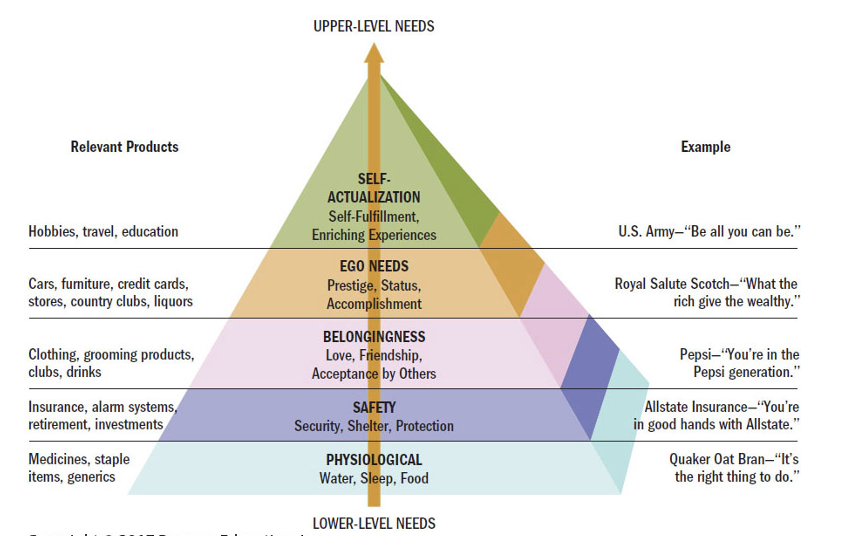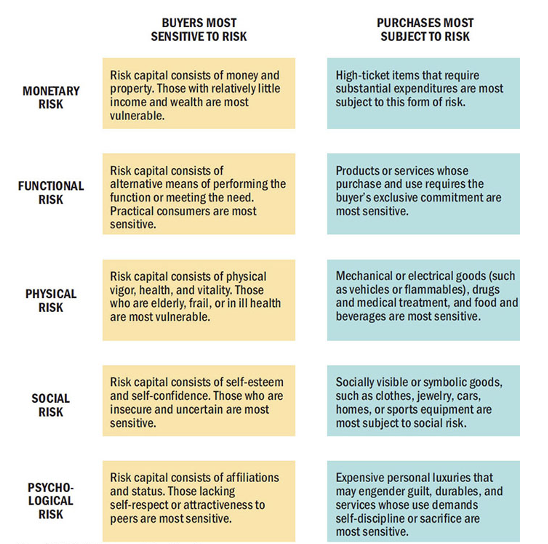Motivation
1/19
There's no tags or description
Looks like no tags are added yet.
Name | Mastery | Learn | Test | Matching | Spaced |
|---|
No study sessions yet.
20 Terms
Motivation
To study motivation, we must understand why consumers do
what they do
Motivation occurs when a need is aroused that must be satisfied
Leads to tension until our needs are met
Goal: our desired end state
How do we reduce tension?
Drive Theory: biological needs produce unpleasant states of arousal > motivates us to reduce and return to homeostasis
If a behavior reduces a drive, we tend to repeat the behavior
How do we explain delayed gratification?
Expectancy Theory: expectations of achieving desirable outcomes
i.e., positive incentives—motivate our behavior (rather than being pushed from within)
We’ll choose one product over another if we think it will have better outcomes
We use drive to refer to both physical and cognitive processes
Needs vs. Wants
Need: basic goal that is necessary for existence (e.g., feeding yourself)
Want: specific pathway used to reaching a desired goal; based largely on our personalities, cultural upbringing, etc.
Needs can be utilitarian (objective, tangible attributes) or hedonic (subjective, experiential attributes)
Whether a consumer's need is utilitarian or hedonic, the magnitude of the tension it creates determines the urgency the consumer feels to reduce it.
Motivational Conflicts
A goal has valence
We approach positive goals and avoid negative outcomes
Approach-Approach Conflict
Occurs when you must choose between two desirable outcomes
E.g., Burger vs. Taco
Cognitive Dissonance: tension that occurs when beliefs or behaviors conflict with each other
Approach-approach conflicts result when both alternatives are positive. The selection of one requires the rejection of another, which creates a need for a cognitive explanation of why one positive choice was not selected.
Postdecision Dissonance: occurs when consumers choose between two products which both have good and bad qualities
How can we convince ourselves that we made the right decision?
Approach-Avoidance Conflict
Occurs when we desire a goal but wish to avoid it at the same time
E.g., Wanting to eat ice cream but not wanting to gain weight
How can marketers help consumers?
Avoidance-Avoidance Conflict
Occurs when we must choose between two undesirable options
E.g., Eating brussels sprouts or ending up with health problems
Marketers will highlight the unforeseen benefits of choosing the option they promote
Extrinsic vs. Intrinsic Motivation
Motivation can come from internal or external triggers
DECIDUOUS TREES II - extrinsic (behaving to reach an external goal or avoid punishment) vs intrinsic (behaving in a way because it’s internally rewarding)
The power of grit
Dr. Angela Duckworth – who is successful and why?
IQ is not a predictor of success
Grit = passion and perseverance, stamina for very long-term goals
It’s a marathon not a sprint
How to build grit?
Dr. Carol Dweck – The power of the “growth mindset”
The ability to learn is not fixed, it can change with your effort
Individuals are more likely to persevere when they fail because they don’t believe failure is permanent
Classifying Consumer Needs
Murray’s Psychogenic Needs (1938): a set of 20 psychogenic needs – including dimensions for autonomy, defendance, and play – that results in specific behaviors
Needs in Consumption
Need for affiliation
Need for power
Need for uniqueness
Maslow’s Hierarchy of Needs
image

Consumers have different need priorities in different consumption situations and at different times in their lives
Physiological: I like to work in the soil
Safety: I feel safe in the garden
Social: I can share my produce with others
Esteem: I can create something beautiful
Self-Actualization: My garden gives me a sense of peace
Involvement
The more motivated we are to achieve a goal, the more involved we are with the process; passion about the topic/product is key
We spend more time and high levels of involvement in product categories
That demand large investments
That involve self-esteem
and less involvement for mundane categories
Types of Involvement
Product Involvement
Message Involvement
Situational Involvement
Product Involvement and Perceived Risk
Refers to a consumer’s level of interest in a particular product
The higher the bond between a consumer and a brand, the higher the involvement
Perceived risk in making the wrong choice increases high involvement in purchase decisions
Types of Perceived Risk
image

Brand Loyalty
Brand Loyalty: repeat purchasing behavior reflecting a conscious decision to continue buying from the same brand
Occurs when involvement in high with a specific product
Consumers have strong positive attitudes towards buying
Sometimes we may engage in brand switching to seek variety
Happens when we become satiated with our favorite
Message Involvement
Refers to our motivation to pay attention to messages
Print is a high-involvement medium
TV is a low-involvement medium
Better engagement when paired with TV shows of high involvement
Messages that are very involving trigger a state of narrative transportation
Message Involvement
You can boost involvement by:
Novel stimuli (sudden silences, unusual cinematography)
Prominent stimuli (loud music, fast action)
Celebrity endorsers
Providing value to consumers
New media platforms
Encourage viewers to think about using the product
Make the message a form of entertainment
Situational Involvement
Refers to engagement with a store, website, or consumption location
You can increase engagement by personalizing messages shoppers receive at the time of purchase